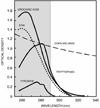Associations between environmental factors and incidence of cutaneous melanoma. Review
- PMID: 22759494
- PMCID: PMC3388446
- DOI: 10.1186/1476-069X-11-S1-S12
Associations between environmental factors and incidence of cutaneous melanoma. Review
Abstract
Background: Cutaneous melanoma is one of the most serious skin cancers. It is caused by neural crest-derived melanocytes - pigmented cells normally present in the epidermis and, sometimes, in the dermis.
Methods: We performed a review of current knowledge on the risk factors of cutaneous melanoma. Relevant studies were identified using the PubMed, Science Direct, Medline, Scopus, Scholar Google and ISI Web of Knowledge databases.
Results: Melanoma incurs a considerable public health burden owing to the worldwide dramatic rise in incidence since the mid-1960s. Ultraviolet radiation exposure is the predominant environmental risk factor. The role of geographical (latitude) and individual factors such as skin type, life style, vitamin D levels and antioxidant protection, sunburn, and exposure to other environmental factors possibly contributing to melanoma risk (such as cosmetics including sunscreen, photosensitising drugs, and exogenous hormones) are reviewed in this article. Recently, both rare high risk susceptibility genes and common polymorphic genes contributing to melanoma risk have been identified.
Conclusions: Cutaneous melanoma is a complex cancer with heterogeneous aetiology that continues to increase in incidence. Introduction of new biomarkers may help to elucidate the mechanism of pathogenesis and individual susceptibility to the disease, and make both prevention and treatment more effective.
Figures


References
-
- Situm M, Buljan M, Bulić SO, Simić D. The mechanisms of UV radiation in the development of malignant melanoma. Coll Antropol. 2007;1:13–16. - PubMed
-
- Little JW. Melanoma: etiology, treatment, and dental implications. Gen Dent. 2006;54:61–66. - PubMed
-
- Habif TP. St. Louis: Mosby. 3rd. 1996. Clinical dermatology: a color guide to diagnosis and therapy; pp. 714–715.
Publication types
MeSH terms
LinkOut - more resources
Full Text Sources
Medical

